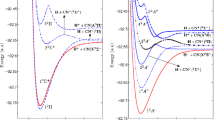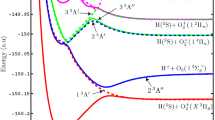Abstract
Polycyclic aromatic hydrocarbons are present in interstellar medium and trapped in water ice. Among these compounds, pyrene has a controversial theoretical excitation spectrum. We carried out time-dependent density functional theory, including the long-range correction functionals, with the aim to help to understand the inversion of the first two UV bands of lower energies. The pyrene molecule was optimized at TD-DFT functionals with Def2svp basis set. The spectrum of pyrene molecule was calculated using implicit and explicit solvent models. The explicit solvent effect was studied, including a cluster of 51 water molecules. The implicit solvent PCM model was used with water and benzene as solvents. CAM-B3LYP and ωB97XD give correct band positions and the ω parameter was also optimized. NBO and frontier molecular orbitals were used to study the UV band inversion.

Analysis of frontier orbitals involved in the lowest energy transitions at TD-DFT of pyrene




Similar content being viewed by others
References
Limão-Vieira P, Anzai K, Kato H, Hoshino M, Da Silva FF, Duflot D, Mogi D, Tanioka T, Tanaka H (2012) Electronic excitation to singlet states of 1,3-C4F6,c-C4F6 and 2-C4F6 by Electron impact - Electron energy-loss spectroscopy and ab initio calculations. J Phys Chem A 116:10529–10538. https://doi.org/10.1021/jp307599y
Bouwman J, Cuppen HM, Allamandola LJ, Linnartz H (2011) VUV photochemistry of PAHs trapped in interstellar water ice. EAS Publ Ser 46:251–256. https://doi.org/10.1051/eas/1146027
Hardegree-Ullman EE, Gudipati MS, Boogert ACA, Lignell H, Allamandola LJ, Stapelfeldt KR, Werner M (2014) Laboratory determination of the infrared band strengths of pyrene frozen in water ice: implications for the composition of interstellar ices. Astrophys J 784:172. https://doi.org/10.1088/0004-637x/784/2/172
Barone V, Biczysko M, Puzzarini C (2015) Quantum chemistry meets spectroscopy for astrochemistry: increasing complexity toward prebiotic molecules. Acc Chem Res 48:1413–1422. https://doi.org/10.1021/ar5003285
Freidzon AY, Valiev RR, Berezhnoy AA (2014) Ab initio simulation of pyrene spectra in water matrices. RSC Adv 4:42054–42065. https://doi.org/10.1039/c4ra05574h
Clairemidi J, Bréchignac P, Moreels G, Pautet D (2004) Tentative identification of pyrene as a polycyclic aromatic molecule in UV spectra of comet P/Halley: an emission from 368 to 384 nm. Planet Space Sci 52:761–772. https://doi.org/10.1016/j.pss.2003.08.029
Kerkines ISK, Petsalakis ID, Theodorakopoulos G, Klopper W (2009) Low-lying absorption and emission spectra of pyrene, 1,6-dithiapyrene, and tetrathiafulvalene: a comparison between ab initio and time-dependent density functional methods. J Chem Phys 131:224315. https://doi.org/10.1063/1.3271347
Mangle EA, Topp MR (1986) Excited-state dynamics of jet-cooled pyrene and some molecular complexes. J Phys Chem 90:802–807. https://doi.org/10.1021/j100277a020
Baba H, Aoi M (1973) Vapor-phase fluorescence spectra from the second excited singlet state of pyrene and its derivatives. J Mol Spectrosc 46:214–222. https://doi.org/10.1016/0022-2852(73)90037-4
Halasinski TM, Salama F, Allamandola LJ (2005) Investigation of the ultraviolet, visible, and near-infrared absorption spectra of hydrogenated polycyclic aromatic hydrocarbons and their cations. Astrophys J 628:555–566. https://doi.org/10.1086/430631
Roos MK, Reiter S, de Vivie-Riedle R (2018) Ultrafast relaxation from 1La to 1Lb in pyrene: a theoretical study. Chem Phys 515:586–595. https://doi.org/10.1016/j.chemphys.2018.08.002
D’Abramo M, Aschi M, Amadei A (2015) Theoretical calculation of the pyrene emission properties in different solvents. Chem Phys Lett 639:17–22. https://doi.org/10.1016/j.cplett.2015.08.070
Bito Y, Shida N, Toru T (2000) Ab initio MRSD-CI calculations of the ground and the two lowest-lying excited states of pyrene. Chem Phys Lett 328:310–315. https://doi.org/10.1016/S0009-2614(00)00936-2
Brédas JL, Street GB (1989) Theoretical studies of the complexes of benzene and pyrene with water and of benzene with formic acid, ammonia, and methane. J Chem Phys 90:7291–7299. https://doi.org/10.1063/1.456207
Estévez-Fregoso M, Hernández-Trujillo J (2016) Electron delocalization and electron density of small polycyclic aromatic hydrocarbons in singlet excited states. Phys Chem Chem Phys 18:11792–11799. https://doi.org/10.1039/c5cp06993a
Park YH, Cheong BS (2006) Theoretical investigation of electronic structures of the ground and excited states of pyrene and its derivatives. Curr Appl Phys 6:700–705. https://doi.org/10.1016/j.cap.2005.04.023
Crawford AG, Dwyer AD, Liu Z, Steffen A, Beeby A, Pålsson LO, Tozer DJ, Marder TB (2011) Experimental and theoretical studies of the photophysical properties of 2- and 2,7-functionalized pyrene derivatives. J Am Chem Soc 133:13349–13362. https://doi.org/10.1021/ja2006862
Salzner U, Aydin A (2011) Improved prediction of properties of π-conjugated oligomers with range-separated hybrid density functionals. J Chem Theory Comput 7:2568–2583. https://doi.org/10.1021/ct2003447
Zara Z, Iqbal J, Ayub K, Irfan M, Mahmood A, Khera RA, Eliasson B (2017) A comparative study of DFT calculated and experimental UV/visible spectra for thirty carboline and carbazole based compounds. J Mol Struct 1149:282–298. https://doi.org/10.1016/j.molstruc.2017.07.093
Garza AJ, Osman OI, Asiri AM, Scuseria GE (2014) Can gap tuning schemes of long-range corrected hybrid functionals improve the description of hyperpolarizabilities? J Phys Chem B 119:1202–1212. https://doi.org/10.1021/jp507226v
Cardinal JR, Mukerjee P (1978) Solvent effects on the ultraviolet spectra of benzene derivatives and naphthalene. Identification of polarity sensitive spectral characteristics. J Phys Chem 82:1614–1620. https://doi.org/10.1021/j100503a009
Svensson M, Humbel S, Froese RDJ, Matsubara T, Sieber S, Morokuma K (1996) ONIOM: a multilayered integrated MO + MM method for geometry optimizations and single point energy predictions. A test for Diels−Alder reactions and Pt(P(t-Bu)3)2 + H2 oxidative addition. J Phys Chem 100:19357–19363. https://doi.org/10.1021/jp962071j
Frisch MJ, Trucks GW, Schlegel HB, Scuseria GE, Robb MA, Cheeseman JR, Scalmani G, Barone V, Mennucci B, Petersson GA, Nakatsuji H, Caricato M, Li X, Hratchian HP, Izmaylov AF, Bloino J, Zheng G, Sonnenberg JL, Hada M, Ehara M, Toyota K, Fukuda R, Hasegawa J, Ishida M, Nakajima T, Honda Y, Kitao O, Nakai H, Vreven T;JA, Montgomery J, Peralta JE, Ogliaro F, Bearpark M, Heyd JJ, Brothers E, Kudin KN, Staroverov VN, Kobayashi R, Normand J, Raghavachari K, Rendell A, Burant JC, Iyengar SS, Tomasi J, Cossi M, Rega N, Millam JM, Klene M, Knox JE, Cross JB, Bakken V, Adamo C, Jaramillo J, Gomperts R, Stratmann RE, Yazyev O, Austin AJ, Cammi R, Pomelli C, Ochterski JW, Martin RL, Morokuma K, Zakrzewski VG, Voth GA, Salvador P, Dannenberg JJ, Dapprich S, Daniels AD, Farkas O, Foresman JB, Ortiz JV, Cioslowski J, Fox DJ (2009) Gaussian 09, revision D.01. Gaussian Inc, Wallingford
Weigend F (2003) Gaussian basis sets of quadruple zeta valence quality for atoms H-Kr. J Chem Phys 119:12753–12762. https://doi.org/10.1063/1.1627293
Rappoport D, Furche F (2010) Property-optimized Gaussian basis sets for molecular response calculations. J Chem Phys 133:134105. https://doi.org/10.1063/1.3484283
Bauzá A, Quiñonero D, Deyaì PM, Frontera A (2013) Is the use of diffuse functions essential for the properly description of noncovalent interactions involving anions? J Phys Chem A 117:2651–2655. https://doi.org/10.1021/jp312755z
Berkowitz J (1979) Photoabsorption, photoionization, and photoelectron spectroscopy, 1st edn. Academic, Cambridge
Hazell AC, Larsen FK, Lehmann MS (1972) A neutron diffraction study of the crystal structure of pyrene, C16H10. Acta Crystallogr Sect B Struct Crystallogr Cryst Chem 28:2977–2984. https://doi.org/10.1107/s0567740872007319
Andersson TA, Hartonen KM, Riekkola ML (2005) Solubility of acenaphthene, anthracene, and pyrene in water at 50°C to 300°C. J Chem Eng Data 50:1177–1183. https://doi.org/10.1021/je0495886
Nakajima A (1977) Fluorescence spectra of anthracene and pyrene in water and in aqueous surfactant solution. J Lumin. 15:277–282. https://doi.org/10.1016/0022-2313(77)90027-8
Acknowledgments
The authors are indebted to the financial support of FAPDF, CNPq, and CAPES and the computational support of CENAPAD/SP and UnB/FINEP Institute of Chemistry Computational Centre.
Author information
Authors and Affiliations
Corresponding author
Additional information
Publisher’s note
Springer Nature remains neutral with regard to jurisdictional claims in published maps and institutional affiliations.
This paper belongs to the Topical Collection VII Symposium on Electronic Structure and Molecular Dynamics – VII SeedMol
Electronic supplementary material
ESM 1
(DOCX 36 kb)
Rights and permissions
About this article
Cite this article
Graef, E.L., Martins, J.B.L. Analysis of lowest energy transitions at TD-DFT of pyrene in vacuum and solvent. J Mol Model 25, 183 (2019). https://doi.org/10.1007/s00894-019-4065-9
Received:
Accepted:
Published:
DOI: https://doi.org/10.1007/s00894-019-4065-9




